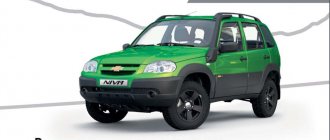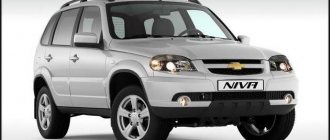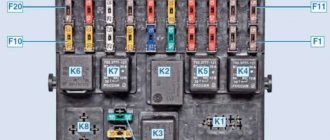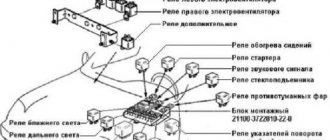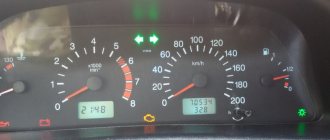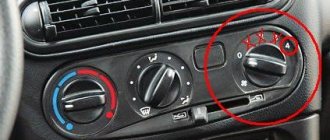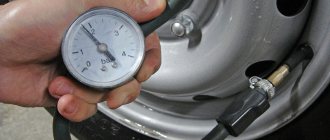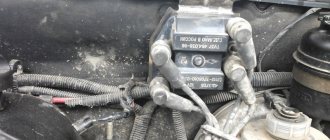- December 10, 2019
- Cars
- Vladimir Skvortsov
The favorite car of fishermen and hunters is the Niva. And the reason for this attitude is the opportunity with its help to get to remote and rarely visited places. What allows you to achieve such results? There is a lock on the Niva. How it helps and in what ways will be discussed below.
Niva drive device
The chassis of the car is made on the principle of permanent all-wheel drive - torque from the power unit is transmitted to all 4 wheels. This scheme improves the performance of the car when driving in off-road conditions, while simultaneously reducing the load on transmission parts.
The Chevrolet Niva drive consists of the following components:
- Gearbox.
- Transfer case.
- A pair of drive and cardan shafts.
- Front and rear axle gearboxes.
The transfer case is designed to distribute torque between the drive axles of the vehicle. The car is equipped with a two-speed transfer case, which provides:
- stable running of the machine when driving at low speed and at high engine speeds;
- power distribution between drive axles, depending on road grip.
The differential is one of the most important elements of the transmission. Its main purpose is to distribute traction force, and, if necessary, ensure rotation of two consumers at different angular speeds. The Chevrolet Niva drive transmission has three differentials:
- One for each axle (inter-wheel) - they allow the wheels of the same axle to rotate at different speeds.
- The third (interaxle action) - transmits power from the power unit to both axles of the vehicle. It also allows the shafts to operate at different angular speeds, depending on operating conditions, which significantly improves controllability.
A pair of cardan shafts (CV joint or cross design) provide connection between the transfer case and the drive axle gearboxes. Both car shafts have the same design - they are interchangeable.
The front and rear axles transmit force from the transfer case to the drive wheels through external and internal angular velocity joints.
Types of blocking
If you want to install a locking mechanism on a differential, you should know that there are two types: full locking; partial blocking. Full blocking mechanisms can operate manually (forced differential locking on the Niva) or automatic mode, while partial blocking is carried out only automatically. Just don’t forget that driving a car with a full lock on a good road leads to premature tire wear. In addition, some parts also fail quickly. Thus, the whole choice comes down to which mechanism to choose: manual or automatic. The manual system has one advantage - the driver himself decides whether to engage the differential lock or not. However, there are also a number of disadvantages: to use the system, you need to remove your hand from the steering wheel; It is imperative to disable the lock in a timely manner, otherwise the chassis of the vehicle may be damaged; high price. The automatic differential lock on the Niva has its own characteristics, among which is the need to customize it to the individual driving style of the car owner. At the same time, the mechanism does not load the car’s transmission as much as its manual counterpart. The system provides complete comfort for the driver, since, if necessary, it is activated without human intervention. It also all depends on your driving style. For those drivers who prefer a quiet ride on a flat road surface, it is better to opt for a viscous coupling or a disc clutch. In case of extreme driving style, you cannot do without a forced differential locking system on the Niva.
The principle of operation of all-wheel drive on a Chevrolet Niva
In normal mode, the Chevrolet Niva operates in high gear with the differential unlocked. Torque is transmitted from the power unit, through the gearbox and intermediate shaft, to a two-stage transfer case gearbox. A center differential is installed in the transfer case housing. It links the front and rear axles, allowing them to rotate at different speeds, depending on road conditions and direction of travel.
How does all-wheel drive work on a Niva with a locked differential?
When all-wheel drive is engaged, both cardan shafts are secured with a locking clutch. This promotes uniform transmission of traction force to both axles of the vehicle. Due to this, the vehicle's cross-country ability increases, but controllability deteriorates.
Advice: It is not recommended to use the lock mode on roads with good grip, as this will lead to accelerated tire wear, increased load on transmission parts and components, and will also increase fuel consumption.
My review of Dak and racing
It just so happened that I had to use the two mentioned types of self-blocks. Their price at the time of purchase was almost the same - ten thousand, the installation is also the same, but the result is completely different.
If the DAK failed after about six months, and not in intensive use, but when driving on ordinary forest roads, then the Togliatti one (val racing) is still working.
Maybe I was just unlucky, but I have repeatedly come across reports that there are problems with the quality of the metal in the production of DAKs. So think for yourself.
Is it necessary?
There are a huge number of opinions about whether a self-block is needed at all, and the most polar ones - from “why is it needed” to “is absolutely necessary.” As always, the choice is a personal matter and everyone must make it themselves.
Again, I will only express my opinion.
It seems to me that everything depends on how and where you move in your car. If you go to the country or mostly on asphalt, then you definitely don’t need a self-block.
The situation is approximately the same if your hobby is off-roading and you are engaged in conquering impassable roads. Here, such “half measures” as self-locking will not work and here you need a full manual differential lock.
However, if your task is to overcome not too severe off-road conditions, driving along a wet, broken forest road, i.e. normal conditions without extreme conditions, then self-block can be a good helper in such conditions.
One should also take into account the fact that when using a self-block, additional significant loads arise on the axle shafts and their breakdowns are quite frequent. Therefore, you need to either install reinforced axle shafts, or if there is a very serious obstacle, do not force the car, but arm yourself with a shovel and a jack and help it cope with the trouble.
Maybe it seems to me, maybe I have the self-locking set up this way, maybe that’s not the issue, but often when the car starts to “slip”, a jerk in the opposite direction suddenly appears. It’s as if the car first went to where the wheel was blocked, and then it gained momentum again, and the car jerks in the opposite direction.
Maybe this is not related to the self-blocking system, but I know this feature of the car’s behavior on a broken road and am always ready for it. Perhaps this will be useful to someone. In all respects the behavior of the car is absolutely normal
A self-locking differential for the Niva is a good addition that, if used correctly, can significantly improve its off-road properties.
How to turn on all-wheel drive
Since the drive on the Niva is constantly all-wheel drive, the question of how to turn on the all-wheel drive on the Niva Chevrolet means how to turn on the center differential lock.
You need to use blocking in the following cases:
- when driving in difficult terrain where there is a danger of wheel slipping;
- when there is a lack of engine thrust;
- when driving on a road covered with snow or ice.
Important: Blocking is useless when the car is hung diagonally, when one wheel on different axles begins to slip. This is due to the design feature of the transmission. In this case, you need to act according to the situation - dig up or pour under the hanging wheels.
The main component of the axle locking mechanism is the transfer case. The transfer case is controlled by one six-position lever. The longitudinal stroke provides higher and lower gear rows. Transverse - responsible for locking the center differential. When the lever is in lock mode, a yellow icon lights up on the instrument panel. There are no synchronizers in the design of the transfer case, therefore, when you try to engage the speed range or lock, the gears clash tooth to tooth. To switch, you just need to move the car forward or backward and then everything will switch.
When to use and how to disable blocking
It is preferable to enable forced blocking in various modifications of the Niva in the following situations:
- The blocking must be turned on in advance if you have to overcome a difficult route.
- On sharp climbs uphill or when driving downhill.
- While crossing terrain with a top layer of sand.
- When you have to drive on snow drifts or an icy road.
Also interesting: Chevrolet Niva or Lada Niva 4x4: which is better, comparison, pros and cons
Wheel locking is not necessary when driving quietly on a flat road within the city. Grip on asphalt surfaces will be decent, and traction will be distributed evenly by default.
Functions of the differential device of the Niva Chevrolet
By automobile differential, experts mean a mechanical installation that includes a set of planetary gears and shafts. The functions of the Chevrolet Niva differential include the distribution of torque from the internal combustion engine of the vehicle to the drive wheels mounted on the same axle. Thanks to this, the car's wheels spin at different speeds.
The ability of the Chevrolet Niva wheels to spin at different speeds is very important when making turning movements. Especially when one wheel runs along a small radius, and the second wheel, located on the same axis, runs along a large radius. If there were no such device as an inter-wheel differential device, the vehicle's wheels would slip.
As a result of such spinning, the car would skid to the side, and the tires would wear out faster and lose their functional features.
When a Chevrolet Niva moves along a straight road at a constant speed, the inter-wheel differential device distributes the thrust from the internal combustion engine evenly between all wheels. This means that both driving wheels will rotate at the same speed. If any drive wheel slips, the differential will increase the traction force on the slipping wheel. As a standard, a passenger car is equipped with one cross-axle differential on the drive axle. There are three such devices for the Chevrolet Niva; they are installed on:
- front axle;
- rear axle;
- at the center of the interaxial action.
A central differential device is needed to distribute the torque to both axles of the vehicle from the internal combustion engine.
Features of cornering
Here it’s worth mentally (preferably on paper) to draw a schematic picture of how the car turns. This promotes better perception. Just when cornering, the differential starts to come into play. And here the differential lock on the Niva can only do harm. The whole peculiarity is that the wheel, which is closer to the center of the turn (inner), moves along a small radius and covers a shorter distance. And the wheel that is located further from the center of rotation (outer), accordingly moves along a large radius and covers a greater distance.
At the same time, increased resistance acts on the inner wheels of the car, which forces them to reduce their speed. On the contrary, the outer wheels need to move faster, due to the same larger radius. And if there were no differential, each turn would lead to increased wear on the tires of the wheels. And if the speed of the car is high, then a skid cannot be avoided. You should know this before installing a differential lock mechanism on the Chevrolet Niva.
This suggests that the wheels must rotate at different angular speeds. When the car begins to turn, the satellites rotate around their axes, which leads to a slowdown in the speed of the axle shaft of the inner wheel, while the angular speed of the axle shaft of the outer wheel, on the contrary, increases.
This is how the vehicle turns smoothly. Despite the difference in angular speeds, the traction force of all wheels is the same, since the main torque does not change. Of course, this is provided that all wheels have the same grip.
Differential blocking of Niva Chevrolet
Since the Chevrolet Niva is an SUV, it needs the ability to enable blocking of all cross-wheel differential devices. This is caused by the need to increase the vehicle's cross-country ability in off-road conditions.
Let's consider the mechanism for blocking the differential device on the Chevrolet Niva:
- if one of the wheels slips, the cross-axle differential will transfer traction force to it from the internal combustion engine;
- the remaining wheels are at rest at this moment, because the traction force will not act on them;
- the vehicle will stop.
Forced blocking of the cross-axle differential is necessary in order to make maximum use of the traction transmitted from the car engine to the drive wheels. Thanks to the action of the components of the differential (these are gears, shafts and a locking clutch), a rigid connection will occur between the drive wheels. That is why the torque will be evenly distributed between both vehicle axles - front and rear. Thus, the cross-country ability of the Chevrolet Niva SUV will increase.
How to determine whether the differential lock is engaged on a Chevrolet Niva
You can determine whether the inter-wheel differential device is locked without even leaving the Chevrolet Niva interior. Let's look at how to do this:
- Find two control levers between the passenger and driver's seats:
- gear shift lever (with long handle);
- machine transfer case control lever (with short handle);
- move the transfer case control lever forward - this will engage a lower gear to the drive axles of the wheels from the gearbox.
- Move the transfer case control lever back - this will disengage the downshift.
- Move the transfer case control lever left and right. This will switch the blocking of cross-wheel differential devices:
- to the left - switch on;
- to the right - shutdown.
As you can see, with the transfer case control lever you can not only change gear levels, but also control the process of blocking the cross-wheel differential device. This is due to the fact that the car differential lock is part of the functioning of the all-wheel drive mechanism of the Chevrolet Niva. The locking switched on at the right moment facilitates the unhindered movement of the SUV in difficult road conditions.
Chevrolet Niva expedition › Logbook › * Self-locking differential in the bridge.
Friends, I want to share with you my short report on the operation of a self-locking differential. I would like to warn you right away that this is my personal opinion, which was formed after two years of using such devices.
We will talk about a screw differential lock. In pursuit of the cross-country ability of my former field, I began to build self-blocks into the bridges. After the sale of the Niva, the megadevices migrated to the Shevik, but were later dismantled. The devices are of course very interesting and really help to increase the vehicle's cross-country ability. The truth is not as much as you might expect. Let's just say that self-locking locks help you get stuck further than a standard differential. Sometimes automatic locking even gets in the way, especially on the front axle. This usually happens in slush or snow, when you need to turn onto a slope. The car stubbornly rows along the trajectory that it likes best, which does not always coincide with the driver’s opinion. Another disadvantage of self-blocks, even if only for the rear axle, is that in order for it to work as expected, frequent maintenance is required. In my experience of operating a Chevy in almost civilian mode, about once a quarter it is necessary to remove the lock to tighten the trigger moment. After half a year it doesn't hold up at all. This happens because the device is built on the basis of friction, and what rubs tends to wear off. If you do nothing after the preload weakens, then nothing bad and nothing good happens. The dissolved self-block begins to work like a regular differential, and simply becomes a “pill for the placebo effect.” It is also worth noting that with a fully working self-block, you need to very carefully gas on any heterogeneous surface, including snow and slurry. Especially on large wheels with pronounced tread. It is very easy to collapse the axle shaft in this situation.
To check the operation of a self-locking differential, it is enough to simulate diagonal hanging. Raise the axle under the axle/lever with a jack and try to move out of such a “trap”. If the self-block does not work (requires re-tensioning), then those wheels that are raised in the air will spin, completely simulating the operation of the most ordinary differential. But I did not suggest this to you, and if you follow this method of verification, you rely entirely on your own peril and risk.
For myself, I came to the conclusion that the best blocking is a forced one, which can be turned off; then it interferes or is simply not needed. And the self-locking differential is too “sporty” and requires a lot of attention to maintain. Therefore, after the last weakening of the preload, I decided that this was not suitable for me.
Thank you all for your attention.
DIY self-block installation instructions
To install a self-locking differential on a Niva, it is not necessary to contact a car service center. It is quite possible to do this with your own hands, provided that the person has a good understanding of the structure of the car. The type of differential and its installation location are not particularly important.
First you need to decide on the place where the work will be done; it should be spacious enough. Using several jacks, you will need to lift the Niva, dismantle the wheels, then drain the engine oil from the gearbox housing into some container and remove the drive axle drive. To do this, just use a spanner to unscrew all the nuts securing the front cover to the gearbox housing, remove the cover and gasket.
Now it is necessary to reliably and efficiently carry out the operation of dismantling the axle shafts, which is very difficult to do without a special puller. The metal is clamped on rotary slots, which requires a lot of effort, which not every person has enough. Dismantling the axle shafts is carried out as follows:
- Unscrew all the bolt nuts on the axle bearing mounting plate.
- The brake mechanism is fixed. This can be done using bolts or wire. If the mechanism is not secured, the brake lines may come off.
- The axle shaft itself is removed. With sufficient skill, this can be done by hand, but it is better with the help of a puller.
Then you need to change the bearings. This will require a hydraulic press. It will help ensure that the holder fits onto the shaft, and with fairly high accuracy. To replace you need:
- Unscrew the hub bearing nut and remove the bushing. Unscrew the nut securing the lever to the steering knuckle.
- Remove the locking plate and unscrew the lever from the steering knuckle.
- Having disconnected all the fasteners, separate the knuckle and the hub with the brake disc. Remove the bearing by first holding the steering knuckle in a vice. During assembly, the bearing is put on using a press.
After the clearances in the main gear are adjusted using special washers of variable thickness, you can begin assembling the unit. Adjusting the gaps is quite difficult, and you will need special equipment, but to ensure accuracy you can use a steelyard. To work with it, wind one end of a 1 m long cord around the flange and secure the other end to the scales. By pulling the device in the winding, you will need to record the turning moment.
To ensure proper operation of the gearbox, the parts are usually sealed before the halves are assembled. In its absence, malfunctions may occur during operation, as well as failure of certain spare parts. After applying the sealant, you need to wait a while for it to harden. Then new oil should be poured into the gear housing. All sealing joints that were damaged during dismantling, as well as those that show signs of oil leakage, must be completely replaced with new ones. Now you can start assembling all the mechanisms in reverse order.
The feasibility of such an action as differential locking on a Niva depends on why the driver needs it. If you need to move through difficult areas, you will need it. If a car enthusiast intends to drive on a normal asphalt road, then installing a self-locking differential on the Niva is hardly worth it. Which self-block to choose and where to place it depends on the driver’s preferences.
Types of limited slip differentials
Disk. No preload, which means it doesn't have smooth tension. The drive wheels begin to rotate simultaneously, but without tension, all starts will be accompanied by impacts on the steering wheel.
Screw. Unlike a disk one, there is already a smooth tension, which does not affect the steering wheel so much. Such self-locking differentials are often installed on front-wheel drive cars, for example, VAZ 2110.
For the VAZ 2121 SUV, the most popular are DAK and DAN:
DAK (Differential Automatic Krasikov). Belongs to the family of automatic ball differentials and provides full locking and evenly distributes the load. According to reviews, its service life is reduced when operating without load, and a hum may appear. An excellent option for installation in a plug-in bridge.
DAN (Nesterov Automatic Differential). This continuation of the DAK allows not only to differentiate the angular speed of the driving wheels of the car during its maneuvers, but also to gently redistribute torque from the engine to the driving wheels.
How to install a self-block?
A self-locking differential is an independent product that is installed in place of the standard one. You can perform this procedure either independently or at a car service center. This is a matter of personal choice, if you have the skill and understanding of how everything works, then you can do it yourself. I installed a self-block at a car service center, and a similar procedure four years ago cost me five grand.
In this case, the determining factor was the need to make the necessary adjustments, set the required gaps, use special stands and other subtleties that I do not know. In any case, after installing the correct self-block (more on this below), no problems arose during its operation.
